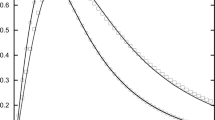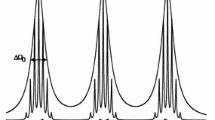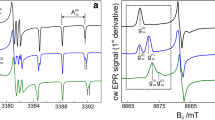Abstract
The behavior of electron paramagnetic resonance spectra due to 15N and 14N nitroxide free radicals undergoing spin exchange in liquids at frequencies \(\omega_{\text{ex}}\) that are high, of the same order of magnitude as the nitrogen hyperfine coupling constant \(A_{0}\), is investigated. The well-known features are reconfirmed: (1) at low values of \(\omega_{\text{ex}}\) where the lines broaden, shift toward the center of the spectrum, and change shape due to the introduction of a resonance of the form of a dispersion component; (2) at values of \(\omega_{\text{ex}}\) comparable to \(A_{0}\), where the lines merge into one; and (3) at values much larger than \(A_{0}\), where the merged line narrows. It is found that each line of a spectrum may be decomposed into an admixture of a single absorption and a single dispersion component of Lorentzian shape. These two- or three-line absorption–dispersion admixtures, for 15N and 14N, respectively, retain their individual identities even after the spectrum has merged and has begun to narrow. For both isotopes, the average broadening and integrated intensities are equal to the predictions of perturbation theory although, in the case of 14N, the outer lines broaden faster than the central line and intensity moves from the outer lines to the central line. In fact, the outer line intensity becomes zero and then negative at higher values of \(\omega_{\text{ex}}\) which is compensated by the central line becoming more intense than the overall integrated intensity. For both isotopes, the dispersion components and the line shifts depart from the perturbation predictions. The results are presented in terms of measurable quantities normalized to \(A_{0}\) so that they may be applied to any two- or three-line spectrum.












Similar content being viewed by others
References
B.L. Bales, M. Meyer, S. Smith, M. Peric, J. Phys. Chem. A 113, 4930–4940 (2009)
B.L. Bales, in Biological Magnetic Resonance, ed. by L.J. Berliner, J. Reuben (Plenum, New York, 1989), pp. 77–130
Y.N. Molin, K.M. Salikhov, K.I. Zamaraev, Spin Exchange Principles and Applications in Chemistry and Biology (Springer, New York, 1980)
J.D. Currin, Phys. Rev. 126, 1995 (1962)
K.M. Salikhov, J. Magn. Reson. 63, 271–279 (1985)
B.L. Bales, M. Meyer, S. Smith, M. Peric, J. Phys. Chem. A 112, 2177–2181 (2008)
B.L. Bales, M. Peric, J. Phys. Chem. B 101, 8707–8716 (1997)
B.L. Bales, M. Peric, J. Phys. Chem. A 106, 4846–4854 (2002)
B.L. Bales, M. Peric, I. Dragutan, J. Phys. Chem. A 107, 9086–9098 (2003)
H.J. Halpern, M. Peric, C. Yu, B.L. Bales, J. Magn. Reson. 103, 13–22 (1993)
B.L. Bales, F.L. Harris, M. Peric, M. Peric, J. Phys. Chem. A 113, 9295–9303 (2009)
B.L. Bales, K.M. Cadman, M. Peric, R.N. Schwartz, M. Peric, J. Phys. Chem. A 115, 10903–10910 (2011)
B.L. Bales, M. Meyer, M. Peric, J. Phys. Chem. A 118, 6154–6162 (2014)
B.L. Bales, D. Willett, J. Chem. Phys. 80, 2997–3004 (1984)
P.W. Anderson, P.R. Weiss, Rev. Mod. Phys. 25, 269–276 (1953)
D. Kivelson, J. Chem. Phys. 33, 1094–1106 (1960)
G.E. Pake, T.R. Tuttle Jr., Phys. Rev. Lett. 3, 423 (1959)
K.M. Salikhov, Appl. Magn. Reson. 47(11), 1207–1227 (2016). (Published online 24 September (2016))
Acknowledgements
The authors wish to thank Dr. K. M. Salikhov for numerous fruitful discussions and for suggesting the term “modes of the spin-coupled system”. M.P. gratefully acknowledges support from NIH Grant SC3GM099635.
Author information
Authors and Affiliations
Corresponding author
Rights and permissions
About this article
Cite this article
Bales, B.L., Peric, M. EPR Line Shifts and Line Shape Changes Due to Spin Exchange Between Nitroxide Free Radicals in Liquids 10. Spin-Exchange Frequencies of the Order of the Nitrogen Hyperfine Interaction: A Hypothesis. Appl Magn Reson 48, 175–200 (2017). https://doi.org/10.1007/s00723-016-0854-9
Received:
Revised:
Published:
Issue Date:
DOI: https://doi.org/10.1007/s00723-016-0854-9




